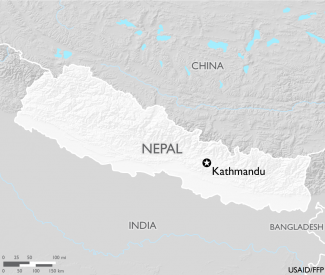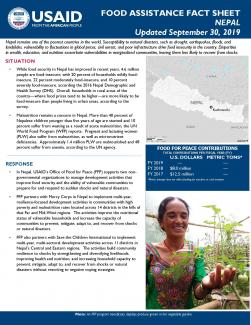September 30, 2019
Nepal remains one of the poorest countries in the world. Susceptibility to natural disasters, such as drought, earthquakes, floods, and landslides, vulnerability to fluctuations in global prices, civil unrest, and poor infrastructure drive food insecurity in the country. Disparities in wealth, education, and nutrition exacerbate vulnerabilities in marginalized communities, leaving them less likely to recover from shocks.
Situation
- While food security in Nepal has improved in recent years, 4.6 million people are food-insecure, with 20 percent of households mildly food-insecure, 22 percent moderately food-insecure, and 10 percent severely food-insecure, according the 2016 Nepal Demographic and Health Survey (DHS). Overall, households in rural areas of the country—where food prices tend to be higher—are more likely to be food-insecure than people living in urban areas, according to the survey.
- Malnutrition remains a concern in Nepal. More than 40 percent of Nepalese children younger than five years of age are stunted and 10 percent suffer from wasting as a result of acute malnutrition, the UN World Food Program (WFP) reports. Pregnant and lactating women (PLW) also suffer from malnutrition, as well as micronutrient deficiencies. Approximately 1.4 million PLW are malnourished and 48 percent suffer from anemia, according to the UN agency.
Response
- In Nepal, USAID’s Office of Food for Peace (FFP) supports two non-governmental organizations to manage development activities that improve food security and the ability of vulnerable communities to prepare for and respond to sudden shocks and natural disasters.
- FFP partners with Mercy Corps in Nepal to implement multi-year, resilience-focused development activities in communities with high poverty and malnutrition rates located across 14 districts in the hills of that Far and Mid-West regions. The activities improve the nutritional status of vulnerable households and increase the capacity of communities to prevent, mitigate, adapt to, and recover from shocks or natural disasters.
- FFP also partners with Save the Children International to implement multi-year, multi-sectoral development activities across 11 districts in Nepal’s Central and Eastern regions. The activities build community resilience to shocks by strengthening and diversifying livelihoods, improving health and nutrition, and increasing household capacity to prevent, mitigate, adapt to, and recover from shocks or natural disasters without resorting to negative coping strategies.
Food for Peace Contributions
Total Contributions:
| U.S. Dollars | Metric Tons | |
|---|---|---|
| Fiscal Year 2019 | ---- | ---- |
| Fiscal Year 2018 | $8.0 million | ---- |
| Fiscal Year 2017 | $12.5 million | ---- |
* Metric tonnage does not reflect funding for vouchers or cash transfers.
Related Resources


